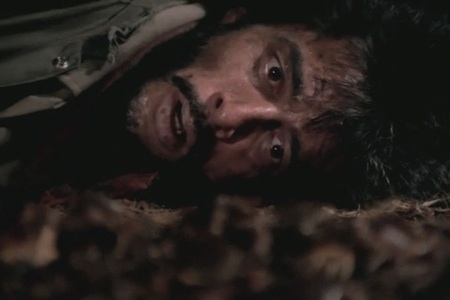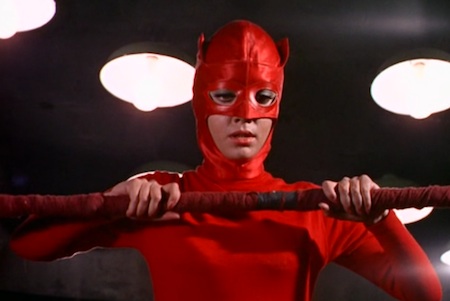For roughly 20 years from the late 1950s onward, movies became much more of a truly international business than they had been since the silent era. When the medium hadn’t learned to talk yet, the lack of a significant language barrier (all you had to do was translate the intertitles) made importing/exporting easier. A few decades later, Hollywood realized that production costs were often cheaper when filming abroad, while local industries outside the U.S. found it lucrative not only to enter into multi-national coproduction deals, but also to make their own usually low-budget genre films primarily for export.Probably the most familiar of these all came principally from Italy—the flood of sword ‘n’ sandal “muscleman” actioners, “spaghetti westerns” and cheap 007-style spy adventures that flooded drive-ins and grindhouses for years, then became TV staples. Equally popular were the countless campy Japanese monster movies that followed the original Godzilla. These weren’t the sorts of movies whose audiences were likely to cry foul over poor, even laughable voice dubbing. Add in a couple “guest stars” already known to foreign audiences—usually aging Hollywood stars who could no longer get top billing back home—and you had a marketable product that could travel the world.Many countries got into the act, including our immediate neighbors. Canadian laws attractive to offshore investors sparked a brief era of mostly disposable “tax shelter” movies that often tried to pass themselves off as being entirely U.S.-made. (The most famous and successful among them was Porky’s—didn’t know that was a Canuck flick, did you?) Mexico’s catering to the international market lasted longer, encompassing dozens of films harder to mistake for Hollywood product despite their foreign cast names and English-dubbed dialogue.That chapter in world cinema can’t possibly be discussed without tipping hat to arguably the nation’s most conspicuous filmmaking dynasty, the Cardonas. Its three generations of writer-director-producer-actors—all named René—have been significant players in Mexico’s film industry (and more recently television) since the 1920s, and do not appear to be finished yet.
Born in Cuba, the elder René Cardona commenced one hell of a busy screen career in 1929, first onscreen, then from 1937 onward as a wildly prolific director and sometime scenarist. (He never stopped acting, either, his last roles being in projects released after his 1988 demise.) He worked in all the popular genres, though it wasn’t until the dawn of the 1960s—international moviemaking’s most favored decade—that his work started being seen widely outside Spanish-language markets. The game-changer was 1959’s Santa Claus, a relatively big-budget fantasy pitting Old St. Nick against that horned devil, Satan himself. Acquired for U.S. release as a kiddie matinee, this bizarre mix of musical, religious morality, cuteness and the macabre baffled children for decades as a broadcast staple, becoming a camp classic in the process.Cardona also directed many of those equally inexplicable (to foreigners) Mexican wrestling movies pairing masked heroes of the mat with horror, sci-fi and action content. These were also exported (and cult-beloved) in dubbed form as children’s entertainment, with Cardona himself responsible for numerous features starring the subgenre’s kingpin, Santo, his chief competitor Blue Demon, and the bodacious “luchadoras” (wrestling women). In 1969 he made one of the most famous of all “Mexploitation” titles, Night of the Bloody Apes, a sexed-up wrestling horror remake of his own prior Doctor of Doom that must be seen to be disbelieved.Night was co-written with son René Cardona Jr., who by the mid-’60s had abandoned his own acting career in favor of writing and directing. He contributed his very own flabbergasting all-time Mexploitation favorite in 1972’s Night of a Thousand Cats, about a rich playboy who picks up pretty strangers (cruising them via helicopter as they suntan on their highrise roofs!), beheads them for his “trophy room,” and feeds the rest to his pit-full of hungry kitties. Yowsa.But it was as a duo, working in various capacities on each other’s projects, that senior and junior Cardonas would most impact international markets. To accomplish this, they combined typical tactics—hiring under-employed veteran Hollywood or European actors, sticking to the most commercial genres, adding plenty of sex and blood—with a particular attention to making their films as box-office relevant as possible. Sometimes this meant creating cheaper knockoffs of huge Hollywood hits; sometimes it meant being first out of the box with a movie about some notorious real-life incident or figure.No one will argue the results were “quality cinema” in an awards-magnet sense. But their sheer shamelessness, among other things, make these movies highly entertaining fodder for the trash enthusiast. When Hollywood’s ’70s disaster-movie was about to wind down with 1979’s Hurricane (a flop, it turned out), the Cardonas beat the gringos to it by rushing Cyclone into theaters first. In the wake of Jaws, René Jr. bit down with Tintorera: Killer Shark (1977). The Me Decade’s favorite conspiracy-theory/supernatural phenomena topic—alongside Bigfoot and UFOs—got its own stranded-boatload-o’-B-actors treatment with The Bermuda Triangle (1978).
The Cardonas were no slouches about ripping material from the headlines. In 1979 alone they contributed the all-star potboiler Guyana: Cult of the Damned—a fictionalized depiction of Jim Jones’ mass-suicidal People’s Temple—and Carlos the Terrorist, a mishmash of news footage and kick-boxy action that covers roughly the same ground as Olivier Assayas’ recent epic docudrama Carlos. Three years earlier Jr. wrote the script for Sr.’s Survive!, a cheesier, less factually accurate account of the same Andes-stranded-rugby-players-resort-to-cannibalism story that inspired the book and much later film Alive. Few would call the Cardonas’ the better movie—but it was, in fact, far more commercially successful.Father and son had a reliable stable of crew and actors (notably hunky Mexican leading men Hugo Stiglitz and Andres Garcia, both still active) they filled out with a shifting roster of international marquee names, however faded: Among them erstwhile Baby Doll Carroll Baker, Citizen Kane’s Joseph Cotton and ex-Mrs. Munster Yvonne De Carlo, plus familiar character actors (Arthur Kennedy, Lionel Stander) and fading Eurobabes (Gloria Guida, Marisa Mell, Marina Vlady). One suspects these shoots were a form of paid vacation for the imported stars, who were likely wined and dined comfortably enough to make up for their less-than-stellar paychecks.What is endearing about the Cardonas’ superproductions isn’t so much their filmmaking dynamism (usually rather slack) or slumming performances (though Stuart Whitman’s “Rev. James Johnson” in Guyana is actually quite chilling), but the resourcefulness that went into delivering bangs for relatively few bucks. Jaws mechanical shark was expensive—so Tintorera splices in real ones that are very seldom seen anywhere near the actors. Further, it shifts our primary attention from death to “little deaths” in the form of mucho sexiness—rampant gratuitous nudity and frolicking, the real plot linchpin being an ongoing ménage à trois in which beach bums Garcia and Stiglitz share pretty, willing tourist Susan George (from the original Straw Dogs). Shake a few bikini bottoms in most viewers’ direction, and they’ll likely forget they were lured in by the promise of shark-mangled torsos.In the 1980s, drive-ins and grindhouses declined as VHS and cable markets grew. Export profits grew smaller, so the Cardonas increasingly turned back toward films intended only for Mexican audiences. Their last hurrahs internationally included 1985 jungle free-for-all Treasure of the Amazon, which is kinda like a 1940s Republic serial with way more breasts and severed body parts. It’s got everything—hairy-spider snacking, death by crab pincer, topless natives, wrestling headhunters, Halloween’s Donald Pleasance as a Nazi, and so forth. It’s one of those movies that refuses to end until everyone has killed everyone. Then there was 1987’s Beaks: The Movie, a very tardy knockoff of Hitchcock’s The Birds featuring The Blue Lagoon’s Chris Atkins. Let’s just say aviary-invasion terror would not experience such cheese again until the much more recent, infamous Birdemic.René Cardona, Sr. passed on shortly thereafter, his namesake son 15 years—and another 30 or so movies—later. The saga was far from over: René Cardona III, who’d appeared in his relatives’ movies as an actor (usually under the name “Al Coster”) since childhood, commenced his own directing career the same year grandpa died. Continuing to use some of his elders’ regular collaborators, he’s cranked out 60 or so features since—none of which have made it into English-language markets, as far as we can tell. Although judging from the looks of such movies as 1989’s witchy horror flick Vacaciones del Terror and the next year’s Free Willy-meets-sci-fi Keiko en Peligro, we wish they would.He appears to have been less active just recently. But one hopes there’s a René Cardona IV waiting in the wings, ready to pleasure and perplex lovers of international genre cinema as soon as he (or she) comes of age.






